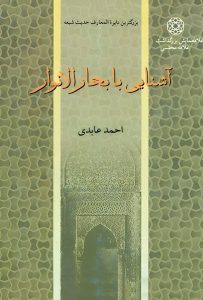Ahmad Abedi, Ashenayi ba Bihar al-anwar [An Introduction to the Bihar al-anwar], Tehran: Ministry of Culture and Islamic Guidance, 1378 Sh/ 1999. 300 pp.
The late Allama Muhammad-Baqir Majlisi (1037-1110 AH/ 1627-1698) was certainly a genius whose influence can hardly be denied. Born to an outstanding clerical family at Isfahan, he received his education first from and before his eminent father, Muhammad-Taqi Majlisi (1003-1070 AH/ 1594-1660). As he was a talented and gifted student, he soon completed his education and made a big name. The present book is in fact an outline survey of his life and the significance of his multi-volume hadith compendium, the Bihar al-anwar. The book under review sheds light on the life and times of Majlisi and his book.

It deserves mention that Allama Majlisi authored several other works, hence the Bihar al-anwar is just one of his works. One gets bewildered how hardworking he was so that he accomplished such incredible research-level tasks.
The book under review has two major sections. The first section in 13 chapters deals with the life and times of Majlisi. The second section, devoted to the Bihar al-anwar, has 23 chapters. In the section devoted to his life, certain outstanding traits of his personality are highlighted. Among them, it is indicated that he was a pioneer of translating hadiths and religious texts from Classical Arabic into Persian. Even as a translator, his Persian prose was outstanding and polite. Although not yet adequately dealt with, his Persian prose sounds quite reader-friendly, not only for the people of his time, but also for us, just after a passage of four centuries. In this section, the socio-cultural environments wherein Majlisi was raised is explained. His outstanding disciples who later on made dignitaries are also listed.
The second section of the book deals in detail with the magnum opus of Majlisi, the Bihar al-anwar. Having surveyed quotations of outstanding Shii clerics on this hadith encyclopedia, it deals with the authenticity of the hadiths it includes. Next, Majlisi’s criteria for including hadiths in this book are adequately examined. It must be noted that the Bihar al-anwar includes many short treatises and books in itself, hence it is a mega-library in its own right. It includes at least 30 short treatises that are of significant value to Shii doctrinal and religious reasoning. As for the sources he drew upon, there are over 460 sources, around 380 of them are Shii works, with the rest those of Sunni hadith collections.
The book under review also deals with the sources written on the Bihar al-anwar, a brief catalogue-oriented overview of the contents of the Bihar al-anwar, and its main divisions and sub-divisions. As it comprises 44 books and 2489 sections, it is necessary for the reader to receive rough orientation toward its main contents and major divisions.

Like many old and medieval works, the Bihar al-anwar received various editions in India, Iran, and Lebanon. These editions were produced under the editorship of various scholars. The last three chapters of the book deal with this bibliographic history of the Bihar al-anwar.
The book under review deserves to be republished as a college textbook. Hence, it is essential to produce an academic edition or version of it for university students, too.
